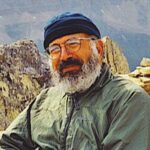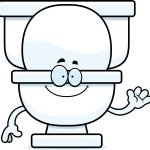While Standing on One Foot …Unipedal Standing and the Treatment of Osteoporosis
Jacob Schor, ND, FABNO
There’s a new exercise to prevent hip fractures in the elderly. It is the simplest, easiest, lowest-cost intervention yet proposed. It is so simple of an exercise and so quick to perform, a person can do it while standing on one foot. Actually, that’s all it is: standing on one foot.
Historical Perspective
The expression “while standing on one foot” refers to the ability to do something quickly and easily. For example, we might say, “David Schleich, president of NCNM, can fund raise money for his school while standing on one foot.”
This is an ancient expression, though, that crosses languages yet retains its meaning. Horace used it in his Satires, written in 35 BC, to describe the poet Lucilius (translated): “In an hour he used to dictate 200 verses, a great feat, standing on one foot.” (Satires 1.4.9-10).
It shows up in the Talmud as well, also first century BC. Hillel, a rabbi who lived in Jerusalem, was accosted by a skeptic asking Hillel to teach him the meaning of the Torah while standing on one foot. Hillel’s famous reply was, “That which is hateful to you, do not do to your fellow. That is the whole Torah; the rest is the explanation … “ (Talmud, Shabbat 31a).
Recent Research
In the October 2006 issue of the Journal of Orthopaedic Science, Sakamoto and colleagues reported on the effect of unipedal standing on frequency of falls and hip fractures in an elderly population.
The “unipedal standing balance exercise” used as a therapeutic intervention was simple: Stand on each leg for a minute with eyes open three times a day. If necessary, patients could hold onto something so they didn’t fall.
The researchers recruited subjects with an average age just less than 82 years and randomized them, some to serve as controls and some to do the ”exercise.“ The number of falls and hip fractures for a six-month period was tracked. Data was collected for 315 unipedal standers and 212 control subjects that presumably rarely stood on one foot.
The 315 subjects in the exercise group recorded 118 falls in the six-month test period. The 212 control subjects recorded 121 falls. There was one hip fracture in each group. The difference in number of falls was statistically significant, but not the number of fractures (Sakamoto, 2006).
Decreasing Hip Fractures
There are two basic ways to decrease hip fractures: prevent falls and strengthen the bone.
Various approaches have been tried to prevent falls. For example, Tai Chi exercises were all the rage a few years back when early studies suggested they decreased the risk of falling significantly. A February 2008 analysis of earlier studies found the data “not convincing” (Lee, 2008). An even more recent review, published in April 2008, suggests that Tai Chi may have some benefit for “relatively young and non-frail” individuals (Low, 2008).
Most interventions suggested for strengthening bones seem to involve making the patient swallow something. Medical doctors have their list of drugs, and we NDs have our lists of supplements. In addition, all of us tell our patients to perform plenty of weight-bearing exercise. Some patients do, but most don’t.
Sakamoto published another article on unipedal standing in the December 2006 issue of Clinical Calcium, which reported that unipedal standing increases the weight load on the femoral head by a factor of 2.75 compared to standing on two legs.
Bone density and bone strength are improved by stress to the bone. That’s why we encourage weight-bearing exercise. It strengthens the bone. Yet to increase bone density by walking, a person has to walk hard; a casual stroll doesn’t work. An October 2007 article in Bone suggests that exercise “sufficient for increases in leg muscle mass and preservation of BMD in postmenopausal women” required “exercise intensities above … 74% of VO2 max, and walking speeds above 6.14km/h.” Only exercise above this provided what is adequate “… mechanical loading … 1.22 times body weight” needed to strengthen the bone (Borer, 2007).
Unipedal Standing as “Exercise”
Unipedal standing produces twice this minimum mechanical loading. By Sakamoto’s calculations, standing on one foot for one minute would have an effect on bone density equivalent to walking for 53 minutes (Sakamoto, 2006).
Repeating this exercise three times a day would have an effect equivalent to taking three almost hour-long walks a day. For older people who are not that mobile, unipedal standing is an interesting option.
Unipedal standing does the two things we want: It improves balance, decreasing spontaneous falls by about one-third. It also strains the bone, mimicking weight-bearing exercise, in theory, strengthening the bone and decreasing the chance of fracture if a person falls.
For those people who are too frail for rigorous workouts or even walking, unipedal standing offers an alternative “exercise.” For those who exercise routinely, a few minutes standing on one foot may still provide added advantage.
There’s little profit incentive for this research, but it’s my hope to see further studies from Sakamoto and his colleagues on unipedal standing. In the meantime, what is it going to cost to get people to stand on one foot a few minutes a day?
Unipedal standing is an example of what I call “simplex res,” or a simple thing. Today, much of what we do in practice relies on complex testing and treatments. It seems as if our profession is being seduced by more and more complicated approaches to treating disease. In contrast to this trend, simple things, such as unipedal standing, are particularly attractive to me.
Our profession’s early doctors might question whether some of our current-day practices still represent the philosophy of medicine they followed. Telling someone to stand on one foot, though … you can’t get much simpler or closer to natural than that.
 Jacob Schor, ND, FABNO is a 1991 graduate of the National College of Naturopathic Medicine and has practiced in Denver for the past 14 years. He served as president of the Colorado Association of Naturopathic Physicians (CANP) from 1992 to 2000, and continues to serve as legislative chair for the organization. He is in practice with his wife, Rena Bloom, ND, current CANP president, at the Denver Naturopathic Clinic.
Jacob Schor, ND, FABNO is a 1991 graduate of the National College of Naturopathic Medicine and has practiced in Denver for the past 14 years. He served as president of the Colorado Association of Naturopathic Physicians (CANP) from 1992 to 2000, and continues to serve as legislative chair for the organization. He is in practice with his wife, Rena Bloom, ND, current CANP president, at the Denver Naturopathic Clinic.
References
Borer KT et al: Walking intensity for postmenopausal bone mineral preservation and accrual, Bone Oct;41(4):713-21, 2007.
Lee MS et al: Tai chi for osteoporosis: a systematic review, Osteoporos Int Feb;19(2):139-46, 2008.
Low S et al: A systematic review of the effectiveness of Tai Chi on fall reduction among the elderly, Arch Gerontol Geriatr April 2008 [In press.]
Sakamoto K et al: Effects of unipedal standing balance exercise on the prevention of falls and hip fracture among clinically defined high-risk elderly individuals: a randomized controlled trial, J Orthop Sci Oct;11(5):467-72, 2006.
Sakamoto K: Effects of unipedal standing balance exercise on the prevention of falls and hip fracture (translated), Clin Calcium Dec;16(12):2027-32, 2006.









